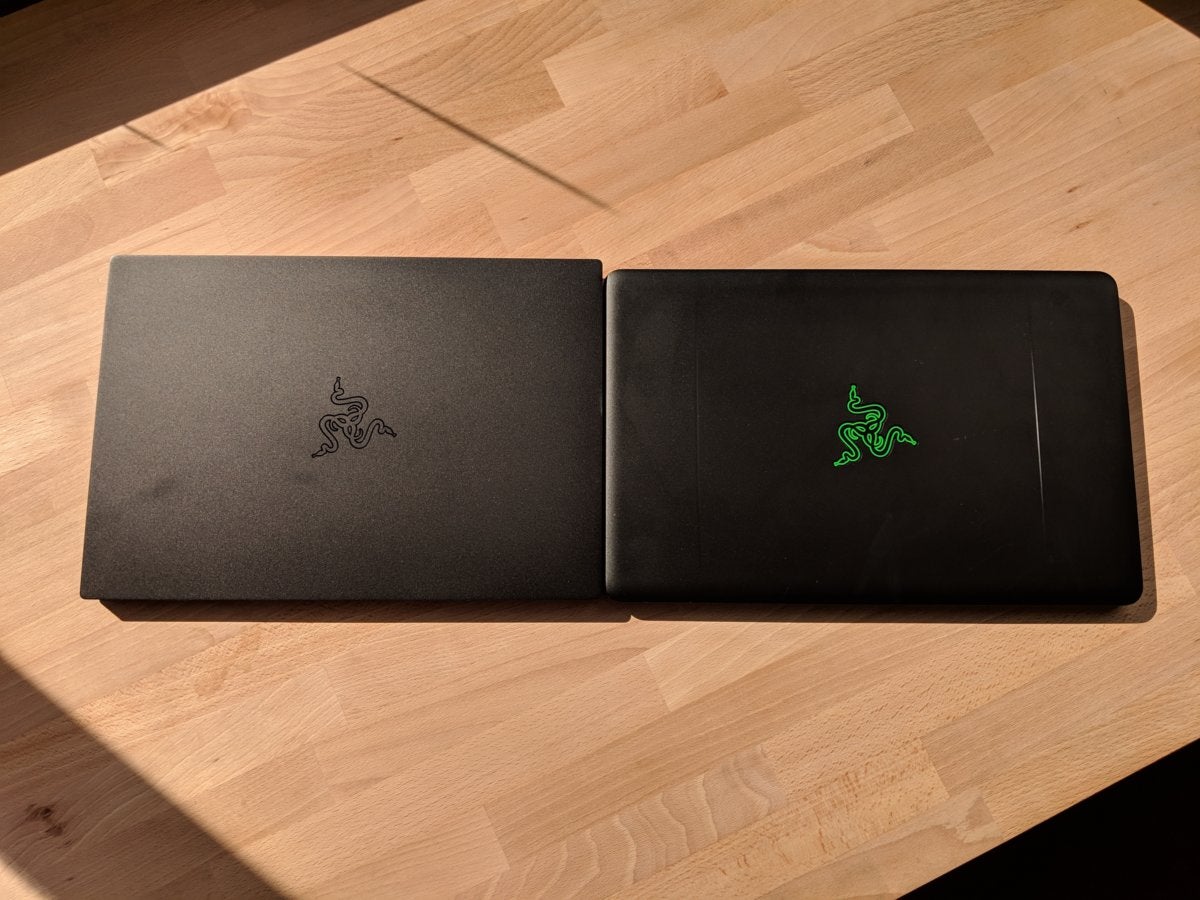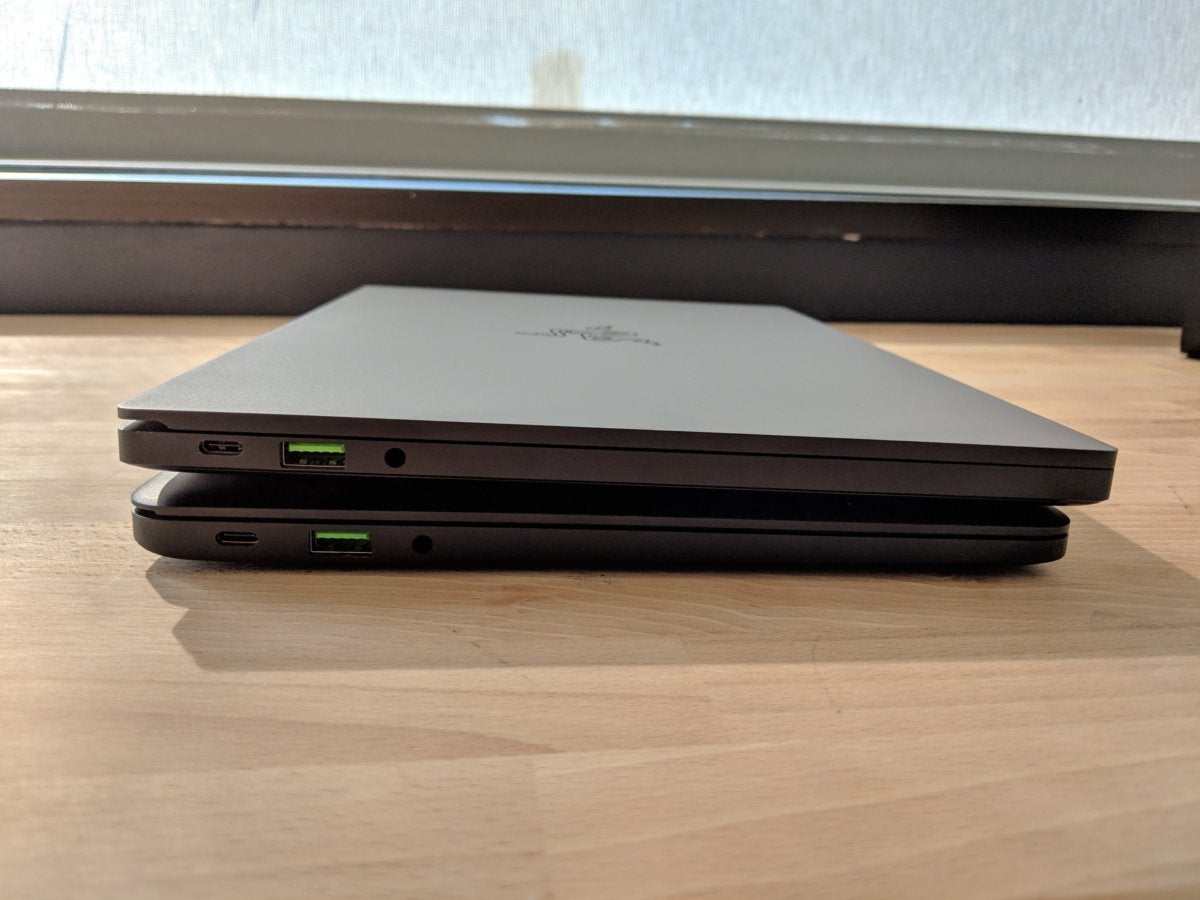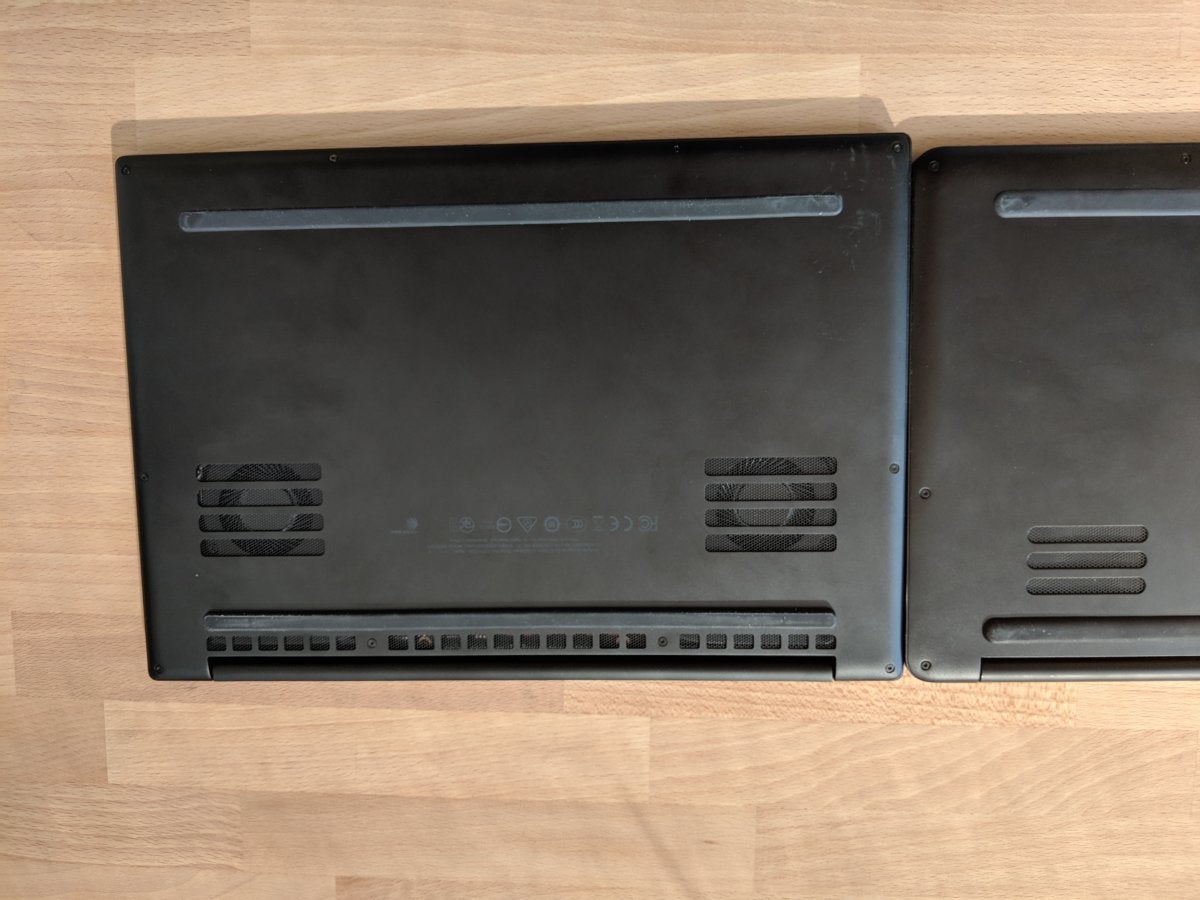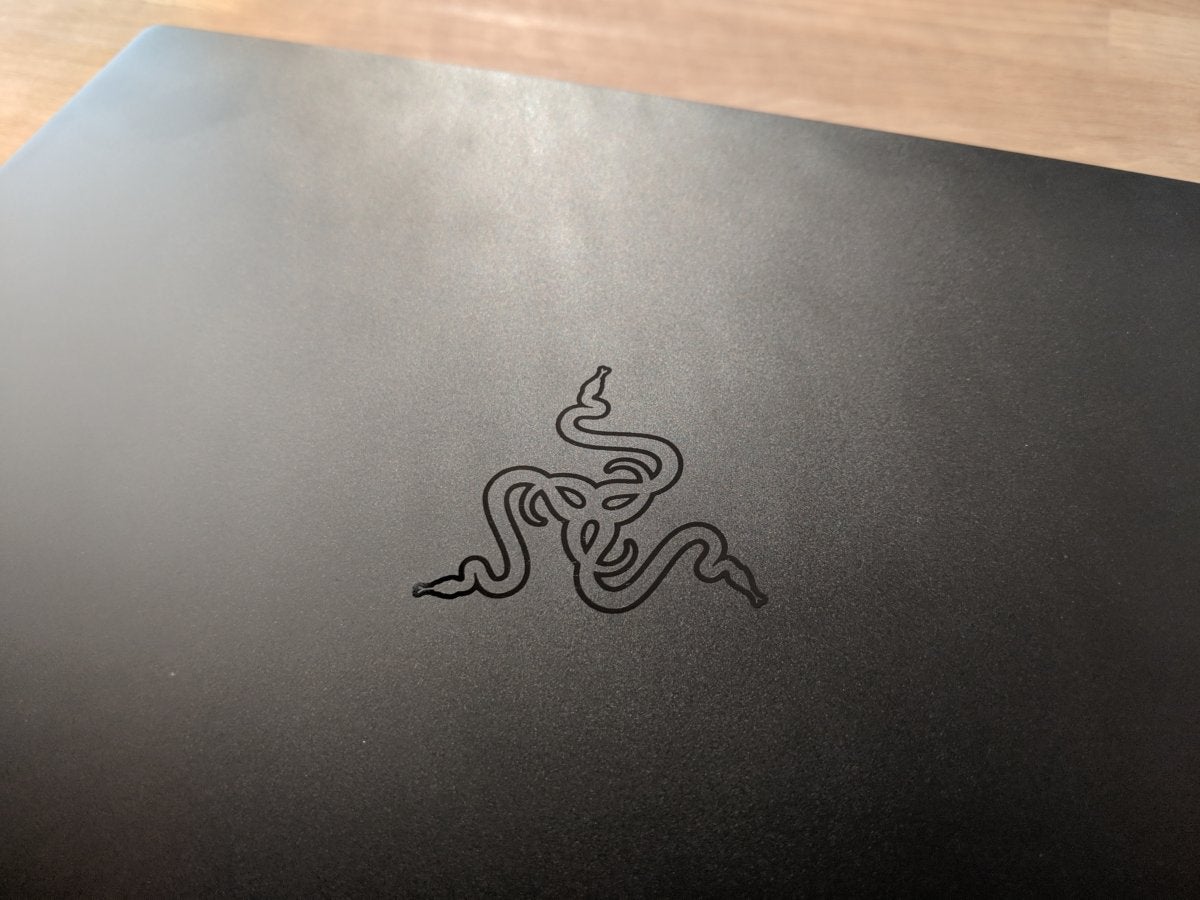Razer’s Blade Stealth gets a long-awaited upgrade to GeForce graphics and a Whiskey Lake CPU - saundersalses1938

Razer
For a company that prides itself on its gaming creds, Razer's 13-inch Razer Blade Stealth has always had one weakness: no discrete graphics.
That just changed Tuesday morning. Razer announced that it has updated the Stealth with Intel's newest 8th-gen (Whiskey Lake) musculus quadriceps femoris-pith Core i7-8565U, along with an Nvidia GeForce MX150 GPU choice. These components are stuffed into a laptop that's merely a smidge larger than its predecessor.
Wherefore this matters: Razer's thin-and-light laptop computer has a great deal of challenger. Bringing in a new CPU and especially the discrete GPU option, along with some other designing and feature tweaks, helps the Razer Blade Stealing tie-up call at a very tough unfit. We'll see which laptops follow—and at what price points.
 Gordon Mah Ung
Gordon Mah Ung The new Razer Blade 13 (left) is only slightly bigger than the previous model, despite the addition of a GeForce MX150 GPU.
Toll, features, and eyeglasses
Razer said the fresh Blade Stealth goes on sales event Tuesday in the United States and Canada. International sales leave follow. Here are the prices and primary features of the base, midrange, and top-tier versions:
Basal pattern ($1,400):
- CPU: Core i7-8550U
- RAM: 8GB of LPDDR3
- Storage: 256GB SATA M.2 SSD
- Display resolution:1920×1080
- Art: Intel UHD 620
Midrange model with discrete graphics and quicker SSD ($1,600):
- CPU: Core i7-8550U
- RAM: 16GB of LPDDR3
- Store: 256GB NVMe PCIe SSD
- Display resolve: 1920×1080
- Graphics: Nvidia GeForce MX150
Top contour, with 4K presentation and larger SSD ($1,900):
- CPU: Core i7-8550U
- RAM: 16GB of LPDDR3
- Storage: 512GB NVMe PCIe SSD
- Video display resolution: 1920×1080
- Graphics: Nvidia GeForce MX150
Note that the screen options include a mill colourize-calibrated 1080p or 4K. Both appear to represent 60Hz and boast 170-degree wake angles.
For ports, Razer includes two USB Type-A ports, one USB Typewrite-C, and combined Thunderbolt 3 port. The only loss is the wide-cut-size HDMI.
Razer claims 13 hours of run time on the base model. We'd guess that's not under heavy CPU or GPU function, which would drain its 53-watt-hour battery within reason quickly.
 Gordon Mah Ung
Gordon Mah Ung The raw Razer Blade Stealth (top) sports a more modern, squared-off profile.
The big news: Whisky Lake CPU, MX150 GPU
The CPU and GPU changes inside the Razer Blade Stealth are significant. The late Razer Blade Stealth maxed out at a quad-essence Kaby Lake R Core i7-8550U with a base clock speed of 1.8GHz to 4GHz. The new quad-core Whiskey Lake U features the same 1.8GHz base clock, but the boost clock is 4.6GHz. With its 10nm CPUs long owed, Intel has continuing to goofball its alive 14nm process for ever high clock speeds. That's a significant time boost if the laptop and CPU can hold high frequencies. We won't know for sure until we test the machine, but they would appear to be able of doing so.
Other potential performance pickups might occur from security mitigation baked into the new Whiskey Lake U chips, kind of than resolved in the UEFI.
Equally for the GPU, Razer said it's using Nvdia's Pascal-based GeForce MX150. The MX150 International Relations and Security Network't new, nor is its use in a 13-inch laptop. We tried and true an Asus Zenbook 13 with the GeForce MX150 earlier this year. What is new is the reading: Razer said it specifically choose the quicker, 25-W MX150 for more performance.
This Revelation follows a petite scandal from earlier this year, when Notebookcheck.com stumbled upon laptops using a 10-Watt interlingual rendition of the GeForce MX150 instead of earlier 25-watt versions. Both enjoyment the unvarying name, and there's no elbow room for a consumer to tell the difference. In any case, much of the Razer Blade Stealth's performance will depend on how well IT's cooled, you bet rough Razer runs the CPU and GPU.
 Gordon Mah Ung
Gordon Mah Ung The cooling ports are big for this model to keep the additional hardware cool.
Razer Blade Stealth design changes
The Blade Stealth boasts outside changes atomic number 3 well. The new laptop is about 11 inches all-embracing, 8.3 inches deep, and just about 0.6-inch thick. It tips the scales at about simply about 2.8 pounds. The scale continues to be aluminum, just gone are the identifiable—and somewhat dated—curves of the preceding model. The updated Blade Stealing has a more chiseled appearance.
Razer shaved the bezels by about 60 percent, ever a wanted alter. Unlike some scraggy-bezel laptop designs, however, Razer keeps the camera at the top of the bezel. (Look you, Dell XPS 13.)
 Gordon Mah Ung
Gordon Mah Ung The Razer Blade Stealth has listed the radiance-common company logo for an understated blackness-on-black reading, the wagerer to blend into business organisatio meetings.
Razer Blade Stealth vs. MacBook Pro 13 and MacBook Air
It gets more interesting when you compare the new Razer Blade Stealing against Apple's ii mid-pasture laptops: the MacBook Pro 13 and the very new MacBook Air.
From a performance perspective, the MacBook Atmosphere isn't in the same class. Although IT's in reality well-nig the like weight as the Razer Sword Stealth, Apple seems to be trying to match in the lead the MacBook Beam with a Chromebook, prioritizing battery longevity over performance. The Razer Blade Stealth will run circles more or less the MacBook Air on Mainframe- and GPU-intense tasks. On the other hand, the MacBook Air, with its low-world power dual-core CPU and integrated graphics, will let a different kinda last laugh because of its longer battery life.
The more interesting battle is with Apple's MacBook Pro 13. The current version features a quadriceps femoris-core Gist i5 as its default CPU, with a Core i7 upgrade choice. Apple does, notwithstandin, use the 28-James Watt versions, which potentially run at higher clocks, while the Razer Brand Stealing has a CPU that believably runs at higher clocks deliberately. In the remainder, they may atomic number 4 pretty confidential.
Where the Razer Leaf blade Stealth has the edge, at least theoretically, is in discrete graphics. Despite its "Pro" moniker, Apple continues to bank on Intel's incorporate graphics rather of a discrete GPU. But the MacBook In favou 13's 28-Watt cow chip, which includes 128MB of eDRAM cache, could surrounding the gap. While we'll reserve judgement until we toilet test, we'd give the Razer Blade Stealing the edge, but perhaps not by as very much like you'd expect along graphics.
One area where Orchard apple tree volition rust Razer's luncheon is in storage. Apple's impost (and permanent proprietary) SSDs have proven to atomic number 4 invincibly bolted.
Banknote: When you purchase something after clicking links in our articles, we may clear a small commission. Read our affiliate link policy for more details.
One of founding fathers of expressed tech reporting, Gordon has been covering PCs and components since 1998.
Source: https://www.pcworld.com/article/403009/razer-blade-stealth-gets-mx150-and-more-price-features-specs-release-date.html
Posted by: saundersalses1938.blogspot.com


0 Response to "Razer’s Blade Stealth gets a long-awaited upgrade to GeForce graphics and a Whiskey Lake CPU - saundersalses1938"
Post a Comment